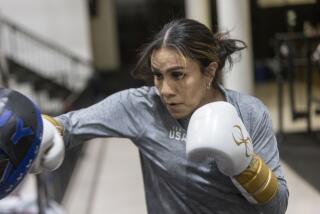A knockout plan
- Share via
“You’ve never seen me like this,” Oscar De La Hoya says loudly, lying on his back on the boxing ring canvas of a Big Bear Lake training gym. “You’ll never see me like this.”
If the strategy De La Hoya refined in the San Bernardino Mountains works as planned, the person he expects to be flat on his back on Dec. 6 is his opponent, Manny Pacquiao.
De La Hoya, 35, hasn’t knocked down a fighter in more than two years, and he hasn’t won by a true knockout since 2000, when he belted the forgotten Derrell Coley. In 11 fights since, De La Hoya suffered four losses and the most impressive of his four technical knockouts came against Fernando Vargas in 2002.
But now, De La Hoya, who has fought at or above 150 pounds in nine consecutive bouts, has a date with current lightweight (135-pound) champion Pacquiao in a bout set at 147 pounds. It was a match made mostly because of the can’t-miss marketing appeal that pits the world’s most popular fighter against the sport’s top pound-for-pound champion.
The Golden Boy’s natural size advantage -- four inches in height and six inches in reach over Pacquiao -- plus a noticeable disparity in power was evident as The Times spent back-to-back days with the boxers recently at their Southern California training camps.
Pacquiao’s rapid-fire hits into the stomach pad of his trainer Freddie Roach were impressive. But De La Hoya’s grunting blasts to his corner assistant’s hand pads make it clear Pacquiao’s gifted speed better be accompanied by brilliant defense.
“I’m scared, I’m scared . . . I’m scared of what I can do to him,” De La Hoya says after nearly three hours of training.
Even those in Pacquiao’s promotional company have privately expressed fears that De La Hoya’s “big left hook” can bring a sudden end to a Las Vegas fight that sold out in less than two hours. De La Hoya is about a 2-1 favorite over the southpaw Pacquiao, according to the MGM/Mirage Race and Sports Book.
“A knockout, that’s my goal,” De La Hoya says. “I can knock you out with one punch. My left is lethal. I can cut you up with a straight jab. If I land an uppercut with full force, the fight’s over.”
And because he returned to training at the 7,500 feet of elevation in Big Bear for the first time in four years, De La Hoya says he feels assured he won’t tire in late rounds as he did in losing a split decision to Floyd Mayweather Jr. and failing to floor Steve Forbes in a bland decision win last May.
Those who time De La Hoya’s mountain runs say he conquers an eight-mile course of hilly trails in 48 minutes. He’s maintaining a disciplined diet that includes kangaroo and deer meat, says he rests often and he weighed in one month before fight night at a manageable 151 pounds.
“I’m not worried about Manny’s youth,” De La Hoya says of his 29-year-old foe. “I’m training for 12 hard rounds, and I’ll be looking for the knockout in the later rounds too, not just the early ones.
“I understand Manny Pacquiao won’t be getting tired. This motivates me. It’s why I chose this fight. I’m glad they’re thinking that they want to take me into deep waters. Let him. They’ll see what my condition is.”
In one scene at his gym, new trainer Ignacio “Nacho” Beristain urged De La Hoya to hold up his left arm before driving his fist forward. Beristain knows Pacquiao well, watching him from the corner of super-featherweight Juan Manuel Marquez, who has fought Pacquiao to a draw (at 126 pounds) and a split-decision loss (at 130). De La Hoya is urged to punch like “a loaded spring,” brother and assistant trainer Joel De La Hoya says.
Roach, De La Hoya’s former trainer and Pacquiao’s current corner man, has said he doubts De La Hoya will implement any new instruction.
“At this point,” Roach says, “all Oscar needs is someone to get him a sip of water between rounds.”
But Joel De La Hoya says, “There’s always room for improvement, and [Oscar] knows that. Nacho opens doors for Oscar. He knows Pacquiao. The game plan is to exploit Pacquiao’s rambunctious style -- throw punches right away and keep the jab out there.”
Given Pacquiao’s fighting style, Beristain is emphasizing to De La Hoya the value of accuracy and proper punching angles, and shifting his weight to maximize the effect of his hard left hook, De La Hoya says.
“I’m still a student of the game,” De La Hoya says. “The day I stop learning is the day I retire.”
In Hollywood, where Roach has been schooling Pacquiao for this fight, the trainer said he was convinced his fighter could handle De La Hoya because of a training-camp episode in Puerto Rico when Roach trained De La Hoya for the 2007 Mayweather bout.
They had brought in a small southpaw, Ivan Calderon, for a session, and De La Hoya “couldn’t hit the guy,” Roach says. “I knew he’d had trouble with speedy, little guys.”
De La Hoya is told that story, and he laughs.
“Freddie . . . he has to be kidding around,” De La Hoya says. “If Freddie is looking at me sparring with Calderon as some secret . . . the guy’s a 106-pounder. I could’ve blown him over. I didn’t want to hurt him. They better change their whole game plan if they’re relying on that.
“I’m always working on different things in here. I have more bad days in the gym than good days. But I’m not a gym fighter, I’m a prizefighter. And when the bell rings, the prizefight begins. I’ll be ready.”
Wednesday: Manny Pacquiao says De La Hoya is not as dangerous as he once was.
--
More to Read
Go beyond the scoreboard
Get the latest on L.A.'s teams in the daily Sports Report newsletter.
You may occasionally receive promotional content from the Los Angeles Times.











